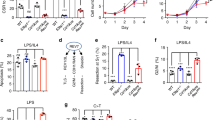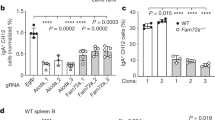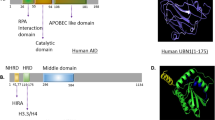Abstract
After gene rearrangement, immunoglobulin variable genes are diversified by somatic hypermutation or gene conversion, whereas the constant region is altered by class-switch recombination. All three processes depend on activation-induced cytidine deaminase (AID)1,2,3,4,5,6,7, a B-cell-specific protein that has been proposed (because of sequence homology1) to function by RNA editing. But indications that the three gene diversification processes might be initiated by a common type of DNA lesion8,9,10,11, together with the proposal that there is a first phase of hypermutation that targets dC/dG12, suggested to us that AID may function directly at dC/dG pairs. Here we show that expression of AID in Escherichia coli gives a mutator phenotype that yields nucleotide transitions at dC/dG in a context-dependent manner. Mutation triggered by AID is enhanced by a deficiency of uracil-DNA glycosylase, which indicates that AID functions by deaminating dC residues in DNA. We propose that diversification of functional immunoglobulin genes is triggered by AID-mediated deamination of dC residues in the immunoglobulin locus with the outcome—that is, hypermutation phases 1 and 2, gene conversion or switch recombination—dependent on the way in which the initiating dU/dG lesion is resolved.
This is a preview of subscription content, access via your institution
Access options
Subscribe to this journal
Receive 51 print issues and online access
$199.00 per year
only $3.90 per issue
Buy this article
- Purchase on Springer Link
- Instant access to full article PDF
Prices may be subject to local taxes which are calculated during checkout




Similar content being viewed by others
References
Muramatsu, M. et al. Specific expression of activation-induced cytidine deaminase (AID), a novel member of the RNA-editing deaminase family in germinal center B cells. J. Biol. Chem. 274, 18470–18476 (1999)
Muramatsu, M. et al. Class switch recombination and hypermutation require activation-induced cytidine deaminase (AID), a potential RNA editing enzyme. Cell 102, 553–563 (2000)
Revy, P. et al. Activation-induced cytidine deaminase (AID) deficiency causes the autosomal recessive form of the Hyper-IgM syndrome (HIGM2). Cell 102, 565–575 (2000)
Arakawa, H., Hauschild, J. & Buerstedde, J. M. Requirement of the Activation-Induced Deaminase (AID) gene for immunoglobulin gene conversion. Science 295, 1301–1306 (2002)
Harris, R. S., Sale, J. E., Petersen-Mahrt, S. K. & Neuberger, M. S. AID is essential for immunoglobulin V gene conversion in a cultured B cell line. Curr. Biol. 12, 435–438 (2002)
Martin, A. et al. Activation-induced cytidine deaminase turns on somatic hypermutation in hybridomas. Nature 415, 802–806 (2002)
Okazaki, I., Kinoshita, K., Muramatsu, M., Yoshikawa, K. & Honjo, T. The AID enzyme induces class switch recombination in fibroblasts. Nature 416, 340–345 (2002)
Maizels, N. Somatic hypermutation: how many mechanisms diversify V region sequences? Cell 83, 9–12 (1995)
Weill, J. C. & Reynaud, C. A. Rearrangement/hypermutation/gene conversion: when, where and why? Immunol. Today 17, 92–97 (1996)
Sale, J. E., Calandrini, D. M., Takata, M., Takeda, S. & Neuberger, M. S. Ablation of XRCC2/3 transforms immunoglobulin V gene conversion into somatic hypermutation. Nature 412, 921–926 (2001)
Ehrenstein, M. R. & Neuberger, M. S. Deficiency in Msh2 affects the efficiency and local sequence specificity of immunoglobulin class-switch recombination: parallels with somatic hypermutation. EMBO J. 18, 3484–3490 (1999)
Rada, C., Ehrenstein, M. R., Neuberger, M. S. & Milstein, C. Hot spot focusing of somatic hypermutation in MSH2-deficient mice suggests two stages of mutational targeting. Immunity 9, 135–141 (1998)
Wiesendanger, M., Kneitz, B., Edelmann, W. & Scharff, M. D. Somatic hypermutation in MutS homologue (MSH)3-, MSH6-, and MSH3/MSH6-deficient mice reveals a role for the MSH2–MSH6 heterodimer in modulating the base substitution pattern. J. Exp. Med. 191, 579–584 (2000)
Lindahl, T. Suppression of spontaneous mutagenesis in human cells by DNA base excision-repair. Mutat. Res. 462, 129–135 (2000)
Sale, J. E. & Neuberger, M. S. TdT-accessible breaks are scattered over the immunoglobulin V domain in a constitutively hypermutating B cell line. Immunity 9, 859–869 (1998)
Zeng, X. et al. DNA polymerase η is an A–T mutator in somatic hypermutation of immunoglobulin variable genes. Nature Immunol. 2, 537–541 (2001)
Rogozin, I. B., Pavlov, Y. I., Bebenek, K., Matsuda, T. & Kunkel, T. A. Somatic mutation hotspots correlate with DNA polymerase eta error spectrum. Nature Immunol. 2, 530–536 (2001)
Manis, J. P., Tian, M. & Alt, F. W. Mechanism and control of class-switch recombination. Trends Immunol. 23, 31–39 (2002)
Petersen, S. et al. AID is required to initiate Nbs1/γ-H2AX focus formation and mutations at sites of class switching. Nature 414, 660–665 (2001)
Chen, X., Kinoshita, K. & Honjo, T. Variable deletion and duplication at recombination junction ends: implication for staggered double-strand cleavage in class-switch recombination. Proc. Natl Acad. Sci. USA 98, 13860–13865 (2001)
Miller, J. H. Experiments in Molecular Genetics, (Cold Spring Harbor Press, Cold Spring Harbor, 1972)
Mokkapati, S. K., Fernandez de Henestrosa, A. R. & Bhagwat, A. S. Escherichia coli DNA glycosylase Mug: a growth-regulated enzyme required for mutation avoidance in stationary-phase cells. Mol. Microbiol. 41, 1101–1111 (2001)
Schouten, K. A. & Weiss, B. Endonuclease V protects Escherichia coli against specific mutations caused by nitrous acid. Mutat. Res. 435, 245–254 (1999)
He, B., Qing, H. & Kow, Y. W. Deoxyxanthosine in DNA is repaired by Escherichia coli endonuclease V. Mutat. Res. 459, 109–114 (2000)
Betz, A. G. et al. Elements regulating somatic hypermutation of an immunoglobulin kappa gene: critical role for the intron enhancer/matrix attachment region. Cell 77, 239–248 (1994)
Jarmuz, A. et al. An anthropoid-specific locus of orphan C to U RNA-editing enzymes on chromosome 22. Genomics 79, 285–296 (2002)
Shen, J.-C., Rideout, W. M. & Jones, P. A. High frequency mutagenesis by a DNA methyltransferase. Cell 71, 1073–1080 (1992)
Navaratnam, N. et al. Escherichia coli cytidine deaminase provides a molecular model for ApoB RNA editing and a mechanism for RNA substrate recognition. J. Mol. Biol. 275, 695–714 (1998)
Selker, E. U. Premeiotic instability of repeated sequences in Neurospora crassa. Ann. Rev. Genet. 24, 579–613 (1990)
Jin, D. J. & Zhou, Y. N. Mutational analysis of structure-function relationship of RNA polymerase in Escherichia coli. Methods Enzymol. 273, 300–319 (1996)
Acknowledgements
We thank A. Bhagwat, P. Holliger, R. Savva, B. Weiss and the Coli Genetic Stock Center for plasmids and bacterial strains; R. Beale and J. di Noia for discussions; J. Sale for comments on the manuscript; and the late César Milstein, a long-term colleague, for encouraging us to work on antibody diversification. S.K.P.-M. and R.S.H. were supported in part by EMBO and Burroughs Wellcome Fund Hitchings–Elion fellowships, respectively; this work was also supported in part by the Arthritis Research Campaign and Leukaemia Research Fund.
Author information
Authors and Affiliations
Corresponding author
Ethics declarations
Competing interests
The authors declare that they have no competing financial interests.
Rights and permissions
About this article
Cite this article
Petersen-Mahrt, S., Harris, R. & Neuberger, M. AID mutates E. coli suggesting a DNA deamination mechanism for antibody diversification. Nature 418, 99–104 (2002). https://doi.org/10.1038/nature00862
Received:
Accepted:
Issue Date:
DOI: https://doi.org/10.1038/nature00862
This article is cited by
-
In vivo diversification of target genomic sites using processive base deaminase fusions blocked by dCas9
Nature Communications (2020)
-
The KT Jeang Prize 2019: Reuben S. Harris
Retrovirology (2019)
-
The cytidine deaminase under-representation reporter (CDUR) as a tool to study evolution of sequences under deaminase mutational pressure
BMC Bioinformatics (2018)
-
Transient AID expression for in situ mutagenesis with improved cellular fitness
Scientific Reports (2018)
-
Post-transcriptional regulation of LINE-1 retrotransposition by AID/APOBEC and ADAR deaminases
Chromosome Research (2018)
Comments
By submitting a comment you agree to abide by our Terms and Community Guidelines. If you find something abusive or that does not comply with our terms or guidelines please flag it as inappropriate.



